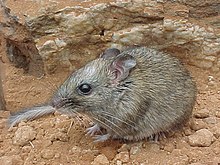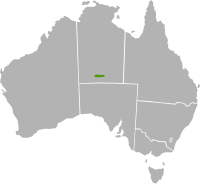Central Rock Rat
| Central rock rat | |
|---|---|
 |
|
| Scientific classification | |
| Kingdom: | Animalia |
| Phylum: | Chordata |
| Class: | Mammalia |
| Order: | Rodentia |
| Family: | Muridae |
| Genus: | Zyzomys |
| Species: | Z. pedunculatus |
| Binomial name | |
|
Zyzomys pedunculatus (Waite, 1896) |
|
 |
|
| Geographic range | |
The central rock rat (Zyzomys pedunculatus), also known as the central thick-tailed rock-rat, Macdonnell Range rock-rat, Australian native mouse,rat à grosse queue (French), or rata coligorda (Spanish), is a species of rodent in the family Muridae that is found only in Australia. The rats have been found in rocky outcrops and on mountainsides with loose stones, as well as hilly grasslands and low open shrubland or woodland. Historically, Z. pedunculatus is only known to be found in a 77 km length of the West MacDonnell Ranges, Northern Territory. The species has previously been recorded from living animals or cave deposits in Northern Territory at Uluru-Kata Tjuta National Park, Illamurta (James Range), Haast's Bluff (West MacDonnell Ranges), Mount Liebig, Napperby Station, Devils Marbles, The Granites (Tanami Desert), and the Davenport Range. It is known from cave deposits in the Cape Range, Western Australia.
The species was believed to have been extinct in both 1990 and 1994 due to population decline. In 2001 individuals were trapped from fourteen locations, but in 2002 drought and wildfire struck the area and the species was not recorded after that. It has been classed as Critically Endangered (Possibly Extinct) by the IUCN Red List. In 2013 they were also discovered by motion-sensor cameras on the Haasts Bluff Aboriginal Land Trust, west of Alice Springs.
The central rock-rat Zyzomys pedunculatus is one of five rock-rat species native to Australia. It is a nocturnal species that specifically forages for food in the nighttime. They can range from 10.6 to 14.9 cm long for the head and body, and around 30 cm from head to tail. They weigh between 50 and 120 g. Their fur is a light mustard above with a pale underbelly . The lightly furred tail is the most noticeable feature of the central rock-rat. The tail base is thick and bulky. The thickness of the tail has been reported to be a fat storage adaptation. This is an effect of scarce food distribution. Rock-rats are known to lose their tails, fur and skin very easily and are, therefore, known to be difficult to handle. As for their birthrate, captive animals have bred and have had litters of various sizes, such as 3, 2, 2, 2, 1, 1 and 4 young.
The Z. pedunculatus diet consists of four major food groups that can be found across all seasons. Seed makes up 72% of the species food intake. The rest of its diet consist of plant leaves (21%), plant stems (3%), and insects (4%). They can be found near rocky habitats for burrow sites and local seed availability. This helps to explain why the Z. pedunculatus is found in such scarce numbers, they rely on constant food supply and a steady and supportive habitat. This makes locating the Z. pedunculatus difficult to find in the Central Australian range. They play an essential role in seed dispersal as well as food resource for other animals in the wild. The species likely has a pattern of recovery and expansion during wet periods, probably due to increased food supply.
...
Wikipedia

